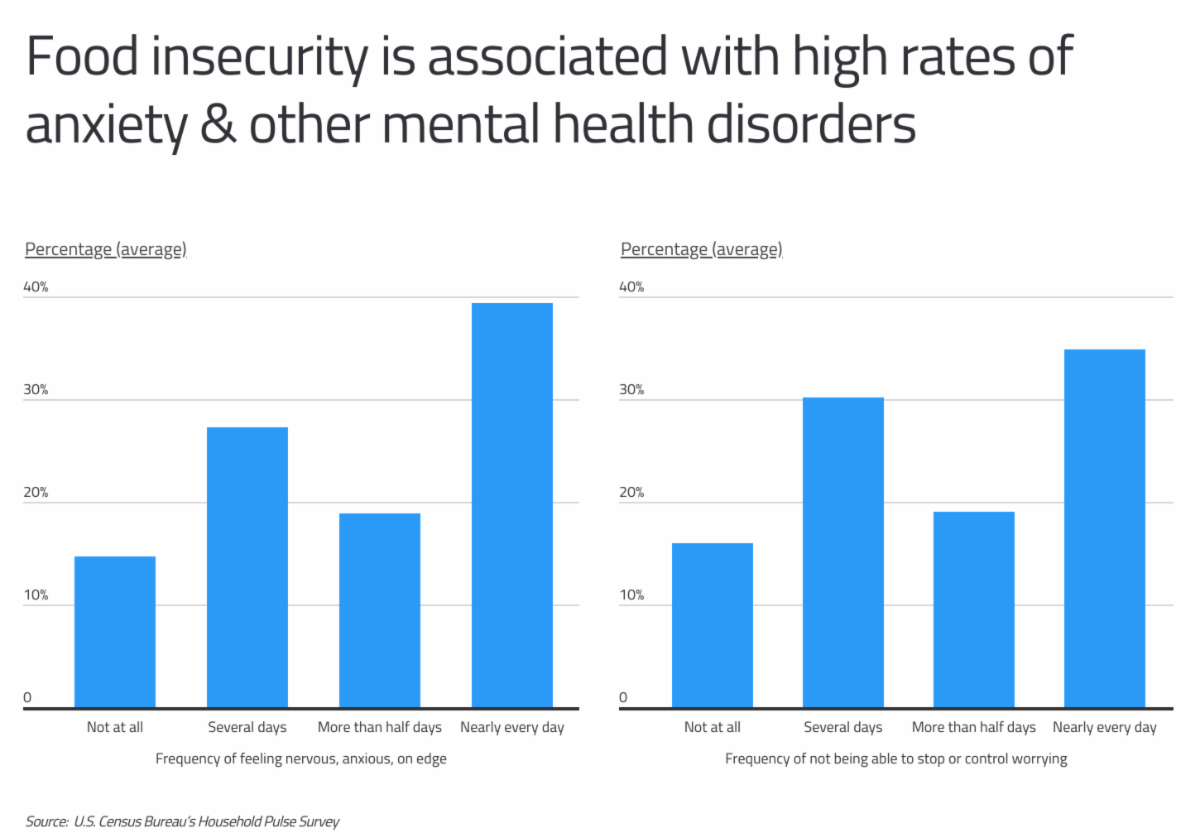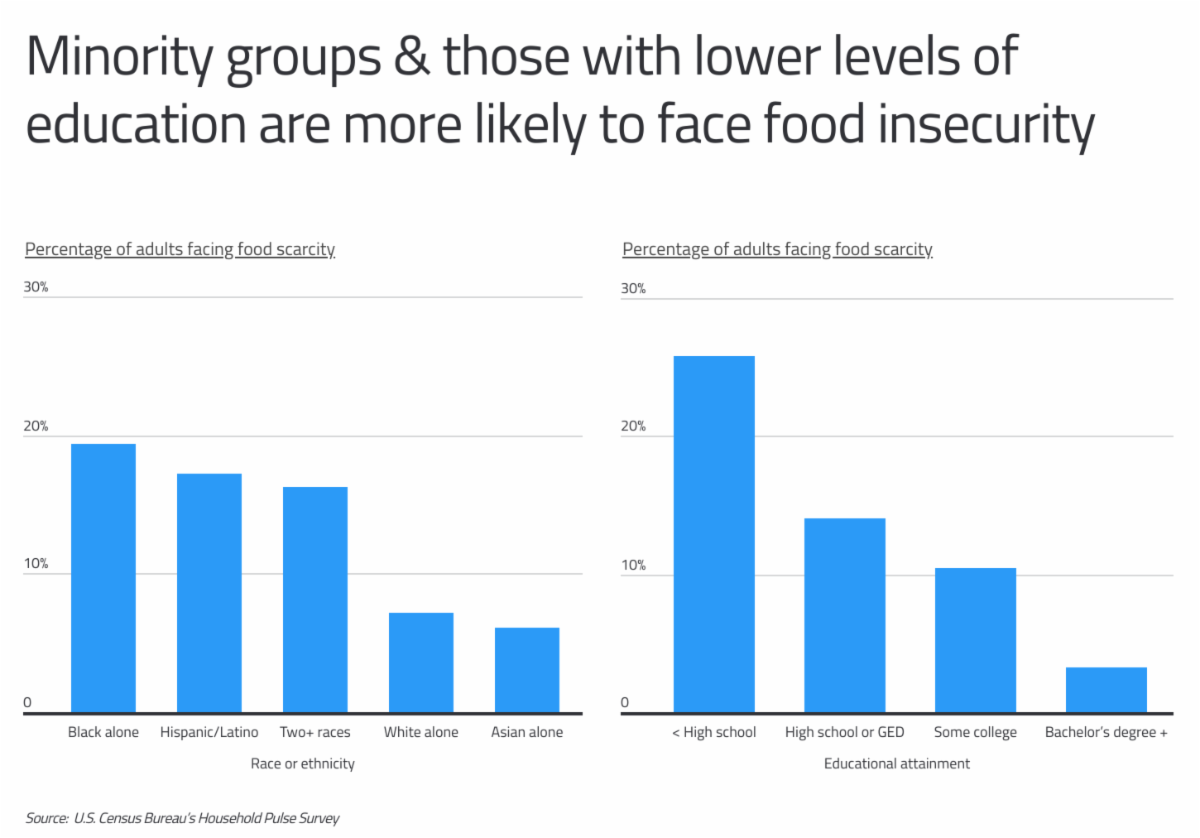Mike LaFirenza
The COVID-19 pandemic created economic hardship for millions of Americans. With the onset of the pandemic in the spring of 2020, the U.S. unemployment rate spiked to 14.8%, and while many jobs quickly returned, millions of workers—many of whom previously worked in lower-wage positions—are still unable to find work or have dropped out of the workforce. Despite robust government efforts to provide relief to households, many families have struggled to meet their basic needs throughout the pandemic, with more ripple effects possible as a result.
One example is food insecurity, a condition defined by the disruption of food intake or eating patterns typically due to a lack of economic resources. Because households need money to obtain an adequate, nutritious supply of food, unemployment is a major factor that contributes to food insecurity. And with the heightened unemployment seen as a result of the pandemic, up to 42 million Americans could face food insecurity at some point this year, according to a report from Feeding America.
Food insecurity is more than a consequence of economic hard times: it is also associated with a variety of health conditions. For one, food insecurity correlates strongly with obesity, as many food insecure individuals are less likely to access or afford fresh, nutritious foods and instead rely more heavily on highly processed items. Chronic disease is also exacerbated by food insecurity, particularly conditions like diabetes, hypertension, or heart disease that are highly affected by diet. And in children, who are one of the most food-insecure populations, poor or inconsistent diets due to food scarcity can contribute to developmental problems.
Food scarcity’s effects on health also extend to mental and emotional wellbeing. This has been particularly true during the pandemic, according to data from the U.S. Census Bureau’s Household Pulse Survey, which surveys U.S. adults on a variety of social and economic indicators each week. Nearly 40% of those who reported that they had sometimes or often not had enough to eat in the prior week also indicated that they felt nervous, anxious, or on edge nearly every day. Further, 35% of those facing food scarcity reported that they were unable to stop or control worrying nearly every day.


And some populations are disproportionately affected by food insecurity when compared to others. One strongly correlated factor is race and ethnicity. Nearly one in five black Americans (19.4%) reported facing food scarcity, with 17.2% of Hispanic Americans and 16.2% of multiracial Americans. In contrast, only 7.2% of White Americans are food insecure, while Asians fare best of all at 6.1%. Disparities are even starker by educational attainment: more than a quarter (25.8%) of Americans who have not completed high school reported food insecurity during the pandemic, compared to 14.1% of those who hold a high school diploma or GED and a mere 3.3% of those with a bachelor’s degree or higher.


Because of food insecurity’s links to other population characteristics, some locations have a higher concentration of food insecure residents than others. Most of the states with the highest rates of food insecurity are located in the South, where the Black population is larger, educational attainment rates are lower, and residents face high levels of poverty and unemployment. The South accounts for nine of the top 10 states with the most food scarcity and 12 of the top 15.
To determine the states with the most residents facing food scarcity, researchers at Commodity.com calculated the percentage of adults in households where there was either sometimes or often not enough to eat, averaged over all available weeks of the Household Pulse Survey. As such, the data represents the typical percentage of adults facing food scarcity at any given point in time during the pandemic, not the cumulative number of people ever facing food scarcity. In the event of a tie, the state with the higher average number of adults facing food scarcity was ranked higher. Researchers also gathered data on poverty and unemployment rates for each of the top states.
The analysis found that in California, 10.9% of adults report living in households where there is either sometimes or often not enough to eat. Overall, California has the 16th highest percentage of residents facing food scarcity in the country. Here is a summary of the data for California:
- Percentage of adults facing food scarcity: 10.9%
- Total adults facing food scarcity: 2,906,852
- Poverty rate: 11.8%
- 2020 average unemployment rate: 10.1%
For reference, here are the statistics for the entire United States:
- Percentage of adults facing food scarcity: 10.4%
- Total adults facing food scarcity: 23,263,858
- Poverty rate: 12.3%
- 2020 average unemployment rate: 8.1%
For more information, a detailed methodology, and complete results, you can find the original report on Commodity.com’s website: https://commodity.com/blog/food-scarcity/
Mike LaFirenza writes for Lattice News Wire
Get Citizensjournal.us Headlines free SUBSCRIPTION. Keep us publishing – DONATE



